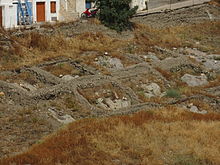Kylindra
Kylindra ( Greek Κυλίνδρα ) is an archaeological site on the Aegean island of Astypalea , the largest ancient children's cemetery.
location
The excavation site is located on the southwestern edge of the island's main town (Chora.) The present-day site is located in the same place as the ancient one on a promontory protruding into the sea, which is crowned by a Venetian castle from the 16th century. Another ancient cemetery, Katselos, is located on the slope of a neighboring hill.
Excavations
Since 1996, under the direction of the 22nd Ephorate of the Greek Archaeological Institute based in Rhodes, the graves of 2,400 small children have been uncovered. The burials called enchytrismos were made in used clay vessels, mostly amphorae , but hydria were also used, where an opening was cut open and then closed again after the body was taken up. The vessels and the associated graves date from the early Archaic period around 750 BC. BC to the 1st century AD, essentially from the period between 600 BC and 400 BC Most of the bones were examined by University College London . It was found that these were mostly infants, sometimes toddlers up to the age of three. Premature babies have also been discovered, with the youngest baby around the 25th week of pregnancy when it was born and buried. As a rule only one child was laid per vessel, but in very rare cases double burials in one vessel occur. Since toddler and infant burials are rarely well preserved due to the not yet consolidated bone structure, the findings of this children's cemetery are special.
The amphorae and vessels come from all over the eastern Mediterranean. In 90% of the cases examined, the body was positioned in the vessels feet first and knees bent, about 10% were placed head first.
The cemetery reserved for infants and toddlers may complement the cemetery for adults and older children of Katsalos, which is also linked to the ancient settlement and represents the same occupancy period. It was assumed that the cemetery of Kylindra is connected to a sanctuary of Artemis Lochia (from ancient Greek λόχος lóchos "birth") and Eileithyia as deities of obstetrics, as inscriptions from the place prove a corresponding cult for the area.
literature
- Anna Clement, Simon Hillson, Maria Michalaki-Kollia: The ancient cemeteries of Astypalaia, Greece. In: Archeology International. Volume 12, 2009, pp. 17-21 ( online ).
Web links
Coordinates: 36 ° 32 ′ 41 ″ N , 26 ° 21 ′ 10 ″ E

